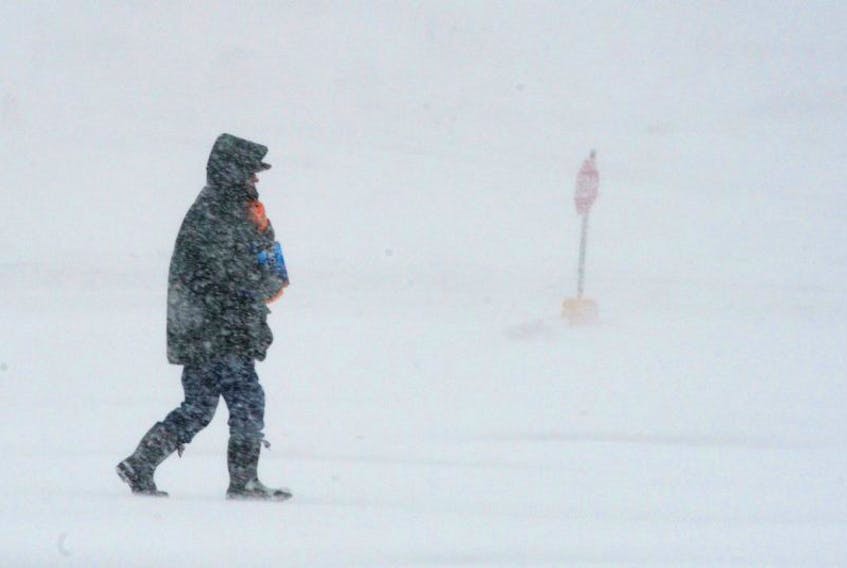Driving to work Tuesday morning, the sidewalks still weren’t plowed along a section of Macdonald Drive in St. John’s, near two schools and a retirement residence, past the College of the North Atlantic and Confederation Building.

There wasn’t a lot of snow down — maybe 15 centimetres or so — but there was enough to make it slippery for drivers and slow going for pedestrians.
It doesn’t take much more snow than that on sidewalks, particularly if there’s a layer already down, to force people to walk in the street, since it is usually the streets that feel the first cut of the plow.
In some cities, such as Vancouver and Toronto, people have turned to the law for remedy when they slip and fall on unplowed city sidewalks or laneways.
But that’s not really an answer, since by then the damage has already been done, and such cases are not easy to prove.
“The odds of success would be very low,” says personal injury lawyer Geoff Budden of Budden & Associates in St. John’s. “The duty on a municipality in circumstances such as that is a relatively low threshold. Public policy recognizes that it’s very difficult to maintain a safe environment 24/7 given our (weather) circumstances. Your biggest challenge would be finding a lawyer to take the case.”
Glen Roebothan, who specializes in personal injury and civil litigation for Roebothan McKay Marshall in St. John’s, agrees.
“I haven’t seen a lot of slip and fall accident (cases) on sidewalks,” he said. “They’re difficult claims to prove. In winter, you’ve got to show negligence. I think employers now, the city included, are very cognizant of keeping very detailed records about what’s done, when it’s done and where. They are able to show that what they did was reasonable in the circumstances.”
So, the city might not have to worry about being snowed under by slip-and-fall lawsuits, but it should be keeping sidewalks clear anyway — not just to keep people safe, but to encourage and enable physical activity all year long.
In St. John’s, where winter can last five or six months, people — particularly those with mobility issues — can be rendered immobile, inactive and isolated if they are fearful of walking on icy, unevenly cleared sidewalks or of having to venture out into narrowed streets alongside slipping, swerving vehicles.
So, the city might not have to worry about being snowed under by slip-and-fall lawsuits, but it should be keeping sidewalks clear anyway — not just to keep people safe, but to encourage and enable physical activity all year long.
Perhaps St. John’s should look to Sweden for inspiration — as Ottawa is now reportedly doing.
That Scandinavian county — which can also see six months of winter — has adopted a “gender-balanced” approach to snowclearing, plowing sidewalks, bike lanes, bus stops and sidewalks near schools first. The term “gender balanced” is an acknowledgement that, in Sweden, women typically walk, cycle and take the bus more than men, who tend to use cars, and it corrects an imbalance that existed for years when streets and highways would be plowed first in winter.
As Streetsblog USA reported on Jan. 24, “Not only was the impact of snow clearance priorities discriminatory, there were negative consequences for society as a whole. Three times as many people are injured while walking in icy conditions in Sweden than while driving. And the cost of those injuries far exceeds the cost of snow clearance.
“So the order was reversed. Municipalities faced no additional cost for clearing pedestrian paths first. And it reduced injuries, in addition to being objectively fairer.”
In St. John’s, I’ve seen no evidence that men are less likely than women to walk, cycle or take the bus, so the rationale here wouldn’t be based on gender imbalance but rather a desire to make streets safer.
While city road crews are often out in force when a storm strikes, the city itself has acknowledged that it takes six or seven days to complete sidewalk plowing.
A week is too many days to be stormbound for people who have to — or want to — travel on foot. It’s too long a time to have to take your chances dodging traffic or be clambering onto slippery snow banks to wait for a bus.
The city should tackle sidewalks sooner, for the good of everyone’s health.
Pam Frampton is The Telegram’s associate managing editor. Email [email protected]. Twitter: pam_frampton









